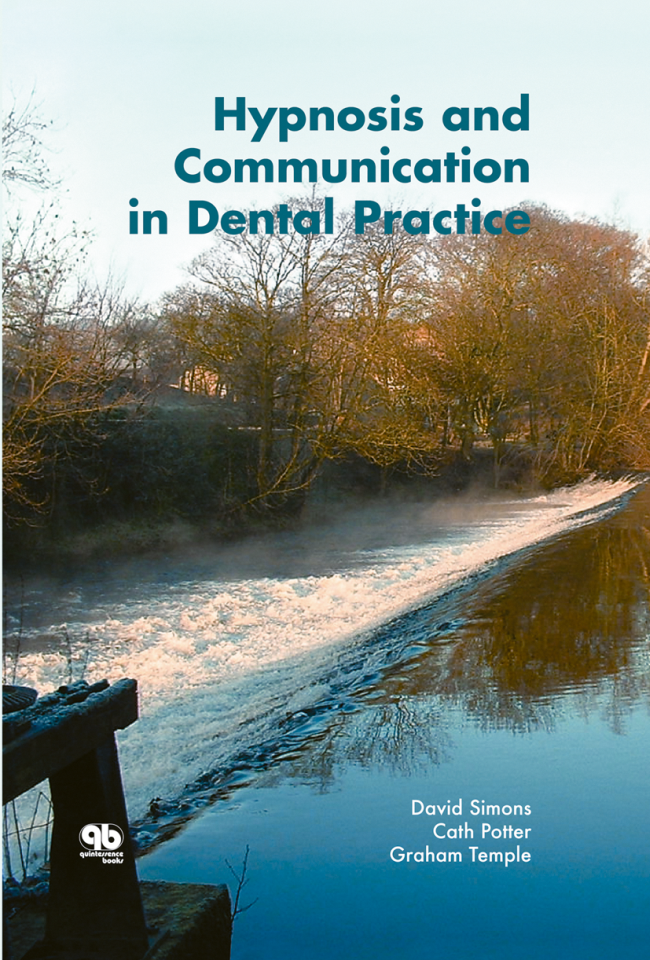Preface
This book is written by dentists for dentists and the whole dental team. Whether you are a student or an experienced practitioner you will find advice and instruction concerning vital aspects of your day to day interaction with patients. Excellent communication skills are an essential ingredient of patient care. When these skills are combined with hypnosis the benefits to patients are profound. There are few disciplines where the two link together as seamlessly and as effectively as they do in dental practice.
Despite the amazing advances in dental technology and pain management that have taken place over recent years dental treatment remains, both in folk-lore and in the minds of many patients, something to be feared, and it is vital that we do all we can to alleviate our patients' apprehension. In Hypnosis and Communication in Dental Practice, we will show you how you can reduce anxiety amongst your patients, and as a consequence work in a less stressed environment.
A common misconception is that hypnosis is time consuming. On the contrary, hypnosis can save a great amount of clinical time through the use of post-hypnotic suggestions and the various other strategies that we describe. Consequently you will find that overall your treatment of many patients will become speedier and much more efficient.
Hypnosis is not something that you use for a particular item of treatment as you might for example apply a topical anaesthetic. It influences everything you do, every word you speak, every gesture you make and every facial expression you display. Hypnosis in dental practice becomes a philosophy which pervades every aspect of your own behaviour, and importantly that of every member of your team. In Hypnosis and Communication in Dental Practice, we demystify clinical hypnosis, demonstrating that hypnosis is not in itself a therapy but that it is a way of providing therapy by enhancing communication, thus enabling suggestions and information to be better absorbed. In this way hypnosis can be used to stimulate new ways of thinking, feeling and behaving.
The processes that we will be describing in this book begin from the first moment that a patient hears of your practice. That first phone call and all the interactions that take place even before you and the patient meet will have a huge impact on your relationship, and consequently upon the ease with which you and the patient can work together. Within this complex interaction the roles that the receptionist, nurses and other members of the team have to play are of paramount importance. In effect all of them will contribute to the ease with which each individual patient will accept both hypnosis and dentistry with you.
Much of this book is about the use of words. We will be examining the ways in which your choice of words, the language you use in your dental practice, has a deep influence upon the comfort and well-being of your patients. To the nervous patient every word you use carries a suggestion, and many of these words will be construed in a negative way by an anxious patient. Dentists who have learned to use hypnosis observe how their language has altered for the better, not merely in the dental practice but also in their selection and usage of words in general conversation.
Similarly, in writing this book we have come to recognise the linguistic challenges of using a vocabulary which is equally applicable across genders and to all the members of the dental team be they dental practitioners, receptionists, dental nurses, dental hygienists or dental therapists. For this purpose, we have generally directed our remarks in this book to you, the reader, rather than using the style of third person, "the therapist." We hope that all your team, and particularly your nursing staff who can play such an important role in communication and hypnosis within the dental surgery, will learn from the book.
As the English language has no adequate word to describe "he or she", we have chosen to use the male gender in describing patients so that, unless a case history refers specifically to a female, the patient will always be referred to as male. Many anxious patients are intimidated by the word surgery, and you will read later in the book of the use of alternative words that might be used in dental practice. However, for the sake of clarity we have chosen to use the word surgery within our text. We are assuming in descriptive passages and in, for example, the sections on ideomotor signaling, induction and deepening techniques, that the dental chair and equipment are set up as for a right handed dentist. Obviously left handed dentists will make appropriate adjustments.
You will often find that our descriptions of the use of hypnosis will be accompanied by scripts. Initially, you may want to use the scripts as written in the book as templates, but soon and inevitably your own personality and vocabulary will come into play, and we hope that quite quickly you will be using your own personality and your own choice of language in your work.
The essential element of any treatment is its safety, and although hypnosis has less potential for harm than, for example, surgery, it is still possible to cause the patient considerable distress and confusion by poor technique. This book does not pretend to provide all the training required. Hypnosis is a practical subject and needs extensive practical instruction to go along with any theoretical knowledge gained. Attempting to treat conditions for which you are neither qualified nor experienced is asking for trouble.
The British Society of Medical and Dental Hypnosis provides courses in the use of hypnosis, and after sufficient training and practical experience, members can apply for Accreditation. Details for contacting both BSMDH and BSECH are given in the Appendix together with information on the Diploma and MSc. level in Hypnosis Applied to Dentistry, at University College London.
Hypnosis and Communication in Dental Practice is a team effort. The three authors come from differing backgrounds within general dental practice, hospital dentistry and dental education, and have taught hypnosis extensively to doctors, dentists and nurses. All have used hypnosis in helping patients to manage a broad range of dental concerns and medical and psychological issues.
The authors share similar views on such fundamental issues as patient-centredness, the individuality of each patient and the importance of providing the highest quality of dental work possible. In personality and in the way these concepts are put into practice there are inevitably, and happily, differences. That is one of the joys of working as a team.
The ultimate aim of this book is to improve the quality of the your working life, and thereby to enhance the quality of dentistry for you, your patients and the entire dental team.








